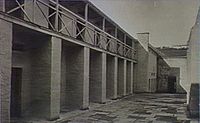Cascades Female Factory facts for kids

Cascades Female Factory, circa 1914–41
|
|
| Location | South Hobart, Tasmania |
|---|---|
| Coordinates | 42°53′38″S 147°17′57″E / 42.8938°S 147.2993°E |
| Status | UNESCO World Heritage Site |
| Security class | Former female factory, penal colony |
| Opened | 1828 |
| Closed | 1856 |
| Managed by | Port Arthur Historic Site Management Authority |
| Type: | Cultural |
| Criteria: | iv, vi |
| Designated: | 2010 (34th session) |
| Part of: | Australian Convict Sites |
| Reference #: | 1306 |
| Region: | Asia-Pacific |
| Place ID: | 10,851 |
The Cascades Female Factory is a very old site in Hobart, Tasmania, Australia. It was a special kind of prison and workhouse for women who were sent to Australia as convicts. This factory operated from 1828 to 1856.
Today, it is one of 11 important places that make up the Australian Convict Sites. These sites are so special that UNESCO has listed them as World Heritage Sites. This means they are important for everyone in the world to protect and learn from.
The Cascades Female Factory shows us how people used to punish and try to change female convicts. It also helps us understand how Britain expanded its influence around the world. Now, the site is a museum and a place for tourists to visit. The Port Arthur Historic Site Management Authority takes care of it. You can visit the site every day (except Christmas) and take different tours to learn about its history.
A Look Back: History of the Factory
Before the Cascades Female Factory was built, some rooms in another prison in Hobart were used for women convicts. But in 1828, the Cascades Female Factory was built just for them. It was meant to keep women convicts away from the bad influences of Hobart. People also thought it would protect society from what they saw as the women's bad behaviour.
However, the factory was built on wet, swampy land. It was also very crowded, dirty, and the women didn't have enough food or clothes. Because of these terrible conditions, many women got sick and died there.
The Cascades Female Factory is the only one of its kind that still has parts of its original buildings. These remains help us imagine what life was like for the women who lived there. It is also on the Australian National Heritage List. In July 2010, it became a World Heritage Site along with ten other Australian convict sites.
New Visitor Centre Opens
Between 2018 and 2019, nearly 35,000 people visited the Cascades Female Factory. To make the experience even better, a new History and Interpretation Centre was planned. A team of architects and designers won a competition to create this new centre in 2018.
The Tasmanian government gave $3 million, and the Australian government gave $2 million to build it. This new centre helps tell the stories of the factory in a more engaging way. The Cascades Female Factory Historic Site, with its new centre, officially re-opened in March 2022. Important guests like Honourable Madeleine Ogilvie MP and Honourable Dame Quentin Bryce spoke at the opening.
Gallery
See also
 In Spanish: Prisión femenina de Cascades para niños
In Spanish: Prisión femenina de Cascades para niños
- Female Factory










